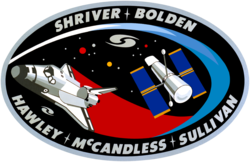Loren Shriver
| Loren Shriver | |
|---|---|
 | |
| Land: | USA |
| Organisation: | NASA |
| ausgewählt am | 16. Januar 1978 (8. NASA-Gruppe) |
| Einsätze: | 3 Raumflüge |
| Start des ersten Raumflugs: | 24. Januar 1985 |
| Landung des letzten Raumflugs: | 8. August 1992 |
| Zeit im Weltraum: | 16d 2h 4min |
| ausgeschieden am | Mai 1993 |
| Raumflüge | |
Loren James Shriver (* 23. September 1944 in Jefferson, Bundesstaat Iowa, USA) ist ein ehemaliger US-amerikanischer Astronaut.
Shriver erhielt 1967 einen Bachelor in Luftfahrttechnik von der United States Air Force Academy und 1968 einen Master in Raumfahrttechnik von der Purdue University.
1967 ging Shriver zur United States Air Force und war von 1969 bis 1973 Pilotenausbilder auf der Vance Air Force Base in Oklahoma. Von 1973 bis 1974 war er in Thailand stationiert. 1975 wurde er auf der Edwards Air Force Base zum Testpiloten ausgebildet und als solcher ab 1976 auch eingesetzt.
Astronautentätigkeit
Im Januar 1978 wurde Shriver von der NASA als Astronautenanwärter ausgewählt. 1985, 1990 und 1992 nahm er an drei Raumflügen teil.
Shriver wurde 1993 Space Shuttle Program Manager for Launch Integration. 1997 wurde er stellvertretender Direktor für Shuttle-Starts und Nutzlasten am Kennedy Space Center. Von 2000 bis 2006 war er stellvertretender Programm-Manager des Space-Shuttle-Programms.
STS-10
STS-10 wurde wegen Verspätungen bei der Nutzlast, einem Satelliten des US-Verteidigungsministeriums, abgesagt. Ken Mattingly, Loren Shriver, Ellison Onizuka, James Buchli und der erste Militärastronaut Nutzlastspezialist der US Air Force Gary Payton waren für diesen Flug im November 1983 vorgesehen gewesen.
STS-41-E
Die Satellitenmission STS-41-E des US-Verteidigungsministeriums wurde wegen Problemen mit der IUS-Oberstufe abgesagt. Ken Mattingly, Loren Shriver, Ellison Onizuka, Jim Buchli und der Nutzlastspezialist der US Air Force Jeffrey Detroye waren als Mannschaft nominiert. Der Start war für März 1984 mit der Raumfähre Challenger geplant.
STS-51-C
Seinen ersten Raumflug unternahm Shriver am 24. Januar 1985 als Pilot der Raumfähre Discovery. Missionsziel von STS-51-C war die Aussetzung eines geostationären Aufklärungssatelliten im Auftrag des US-Verteidigungsministeriums.
STS-61-M
Die Mission STS-61-M der Challenger hätte im Juli 1986 einen TDRS-Satelliten ins All bringen sollen. Die Crew hätte aus Loren Shriver, Bryan O'Connor, Mark Lee, Sally Ride, William Fisher und dem US-Industrieastronauten Nutzlastspezialist Robert Wood bestanden. Nach der Challenger-Katastrophe wurde dieser Flug abgesagt.
STS-31
Shrivers zweiter Flug begann am 24. April 1990, er war Kommandant der Raumfähre Discovery. Hauptaufgabe von STS-31 war das Aussetzen des Hubble-Weltraumteleskops. Daneben wurden mit einer IMAX-Kamera Aufnahmen von der Erde gemacht.
STS-46
Am 31. Juli 1992 startete Shriver als Kommandant des Space Shuttles Atlantis zur Mission STS-46. Während des achttägigen Fluges wurde der Satellit EURECA ausgesetzt sowie Erprobungen mit dem Tethered Satellite System (TSS) durchgeführt.
Privates
Loren Shriver ist verheiratet und hat vier Kinder.
Siehe auch
Weblinks
- NASA-Biografie von Loren Shriver (englisch; PDF)
- Biografie von Loren Shriver in der Encyclopedia Astronautica (englisch)
- Kurzbiografie von Loren Shriver bei spacefacts.de
| Personendaten | |
|---|---|
| NAME | Shriver, Loren |
| ALTERNATIVNAMEN | Shriver, Loren James (vollständiger Name) |
| KURZBESCHREIBUNG | US-amerikanischer Astronaut |
| GEBURTSDATUM | 23. September 1944 |
| GEBURTSORT | Jefferson, Bundesstaat Iowa, USA |
Auf dieser Seite verwendete Medien
STS-46 Mission Insignia
STS-31 shuttle mission flight insignia. The mission insignia for NASA's STS-31 mission features the Hubble Space Telescope (HST) in its observing configuration against a background of the universe it will study. The cosmos includes a stylistic depiction of galaxies in recognition of the contribution made by Sir Edwin Hubble to our understanding of the nature of galaxies and the expansion of the universe. The STS-31 crew points out that is it in honor of Hubble's work that this great observatory in space bears his name. The depicted Space Shuttle trails a spectrum symbolic of both the red shift observations that were so important to Hubble's work and new information which will be obtained with the HST. Encircling the art work, designed by the crew, are the names of its members.
The crew insignia for STS Flight 51-C includes the names of its five crewmembers. The STS 51-C mission marked the third trip of the Space Shuttle Discovery into space. It was the first Space Shuttle mission totally dedicated to the Department of Defense. The U. S. Air Force Inertial Upper Stage Booster Rocket was successfully deployed. Due to the nature of the mission, few additional details of the flight were made available. Landing was made at the Kennedy Space Center, FL on January 27 at 4:23 PM EST. Mission duration was three days, one hour and 33 minutes.
Loren James Shriver



